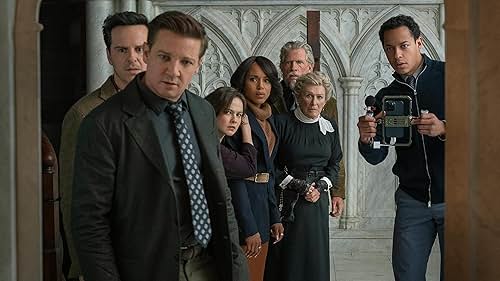Wake Up Dead Man: A Knives Out Mystery
Posted on January 2, 2026 at 9:34 pm
B +| Lowest Recommended Age: | High School |
| MPAA Rating: | Rated PG-13 by the MPAA for violent content, bloody images, strong language, some crude sexual material, and smoking |
| Profanity: | Strong and crude language |
| Alcohol/ Drugs: | Drinking and drunkenness |
| Violence/ Scariness: | Gristly violence, graphic and disturbing images, murders |
| Diversity Issues: | None |
| Date Released to Theaters: | November 22, 2025 |
| Date Released to DVD: | December 13, 2025 |
I love Rian Johnson‘s “Knives Out” movies, and this latest one had everything I hoped for: a twisty plot, a knock-out cast, a dash of commentary about contemporary life and searching for meaning. Also: searching for money. Power, too, but especially money. Writer/director Rian Johnson makes each film in the series a different setting and tone, so instead of “Glass Onion’s” sunny setting in a huge, art-filled mansion on a Greek island, this one has a gothic feeling, set in and around a spooky Catholic Church in upstate New York.

It begins with a literal knock-out. An idealistic young priest named Father Jud Duplenticy (2025’s MVP Josh O’Connor, in his third of four films released this year) punches another priest in the nose for some unnamed offensive remark. Father Jud came to the Catholic church after a brief career as a boxer and a period of feeling lost and guilty. He is devoted to his calling as a way to share healing, encouragement, trust, and community.
He is assigned by his bishop (Jeffrey Wright) to be assistant priest to the imperious Monsignor Jefferson Wicks (Josh Brolin). Even the names have a gothic ring. Monsignor Wicks (do NOT call him Father) has a small coterie of devoted followers and enjoys being so bombastic and judgmental from the pulpit that anyone outside that group walks out of the service. He is not happy to have Father Jud and immediately accuses him of trying to take over the church. Then he insists on giving his confession and intentionally makes it as uncomfortable for Father Jud (though hilarious for the audience) as possible.
Glenn Close plays Martha Delacroix (I told you about the names), who is the church’s pretty much everything but the priest. She runs the office and fills the chalice. As a child, she was devoted to Wicks’ grandfather, a widower with a daughter who became a priest, and it has been the center of her life ever since.
The Wicks loyalists are groundskeeper Samson Holt (Thomas Hayden Church), who is in love with Martha, popular author turned fanatic Lee Ross (Andrew Scott), currently working on a book about Wicks with a strong overlay of conspiracy theories, ailing young cellist Simone Vivane (Cailee Spaeny), who believes Wicks will find a way to cure her through faith — and her generous financial contributions, doctor Nat Sharp (Jeremy Renner), devastated because his wife left him, and attorney Vera Draven (Kerry Washington), who gave up her dream of advocating for the public good to follow her father as lawyer for the church. Her father also told her she had to be responsible for Cy, a young boy he brought home. Cy (Daryl McCormack) is now an adult, back living with Vera after a failed political campaign, and trying to make a comeback as an influencer, posting Wicks’ sermons.
This is a nicely toxic soup for what will turn out to be that favorite of mystery authors and fans, a locked door murder. A body is discovered in a locked alcove near the pulpit during a service with everyone in the pews as witnesses that the murder victim was the only one who entered. The sheriff shows up (Mila Kunis) and of course so does master murder-solver Benoit Blanc (Daniel Craig).
Composer Nathan Johnson, as he did on the two previous films, enhances the story with evocative music, starting with screechy strings in the first scene and reaching for resolution.
As with the earlier films, there is some sharp commentary on contemporary culture, but the film is always respectful of Father Jud’s sincerity and his attempts to create a caring environment for the congregation. O’Conner continues to impress with his exceptional range and the precision of his characterization. Like the other two British actors, Scott and McCormack, he has an impeccable American accent. With so many characters, some are more clearly defined than others. Kunis and Washington do not get a chance to show much depth to thinly drawn roles, but Bridget Everett of “Somebody Somewhere” makes the most of a tiny part as an employee of a local company who has some crucial information for Blanc and Father Jud. Like the priest, we quickly move from irritation to empathy as she keeps him on the phone. And then we get to enjoy the twists and surprises. Can’t wait for the next one.
Parents should know that this is a murder mystery with violent deaths. Characters drink alcohol and there are references to a child born out of wedlock and an adult who is a drug abuser and has sex with many people. There are very explicit sexual references.
Family discussion: What drew each of the members of the congregation to Monsignor Jefferson Wicks? Why was Martha so loyal? What will Father Jud do next?
If you like this, try: the other “Knives Out” movies, Agatha Christie films like the original “Murder on the Orient Express,” “And Then There Were None,” and “Witness for the Prosecution,” as well as locked room classics like the one mentioned in the film, Hollow Man by John Dickson Carr.






